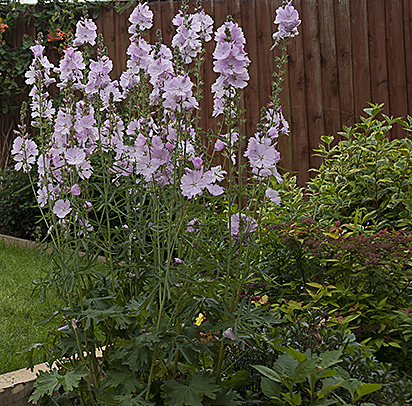For this set of images I've used a zoom lens since the aim of this exercise is to vary how much the subject fills the frame. I've used an aperture of f/8 in aperture priority as I know this will give a reasonable sharpness of foreground, subject and background which I need for the exercise.
I've deliberately not used any creative use of focus or paerture in this set of images
All images in this exercise have been resized to 800 across the longest sized and saved as jpegs around 250kb to make uploads / downloads easier
Image 1 - Quickly Composed Image
This is a quickly composed shot in portrait mode so that the whole of the image is in the frame. Other than this, no real compositional consideration has been given other than making it clear what the subject of the image is, a herbaceous plant.
Image 2 - Frame Filled Image
In this image I've filled the from and tilted the lens slightly downwards to ensure the whole of the plant has been captured in the frame. In reality I would likely have not captured the bottom element of the plant for this image.
Image 3 - Subject Framed in its Surroundings
Using a wider angle the plant is now seen in its surroundings which may not have been fully clear in the earlier images.
Image 4 - Varying the Size in the Frame
This image 3, printed, marked up with potential crop options and scanned in.
Image 4a - Crop Options
This crop doesn't offer much interest to the viewer in my opinion
Image 4b - Crop Options
Image 4c- Crop Options
This image crop I think is better than the 2 crops above but I think had my initial visualisation have been to create an image of this sort then I feel I would have filled the frame with the flower heads at the start and then attempted variations of angles and camera position to explore and exploit a better image
Exercises Learning's
a) the photographer should really start with an initial visualisation of the time of image he wants to create. This will allow a more focused approach at the start and some exploration may allow some alternate images to be produced
b) the initial visualisation should include an idea around camera orientation and the degree to which the photographer wishes the subject or subjects to appear in the frame. This visualisation might also include a crop requirement as part of later processing e.g. the frame shape isn't the shape of the image desired, there may be some elements the photographer doesn't want in the image.
c) an image cropped too tightly may become to constricted but in opposition it may also allow more abstract in the image where domination is perhaps desired
d) the view finder is a good guide to the size of the frame we want to fill but the photographer should not allow himself to be completely restricted by this e.g. the photographer may want to create a letterbox type of image where the full width of the view finder view is to be included bit necessarily the full height.
e) Consideration by the photographer of how to fill the frame helps slow the photography process down, avoids rushing the taking of images and allows some more thought, consideration and perhaps additional generation of ideas. Great for static subjects but perhaps not always possible for moving or spontaneous images. However having an initial visualisation will allow a greater chance of creating what was intended.







No comments:
Post a Comment